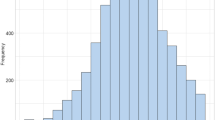Abstract
Resilience is a concept which presents the strength of mind necessary to adopt the difficulties and to recover from negative psychological state. The assessment for resilience has been assessed by using interview and questionnaire which depend on subjectivity of participants. Though the objective assessment for resilience is expected to advance the biofeedback treatment, neither effective method nor instrument have been developed. Then this study focuses on the pliability as one of aspects of resilience and experimentally verifies whether it becomes a novel index for resilience or not.





Similar content being viewed by others
Explore related subjects
Discover the latest articles and news from researchers in related subjects, suggested using machine learning.References
Grotberg EH (1999) Tapping your inner strength; How to find the resilience to deal with anything. New Harbinger Pubns, Oakland
Masten AS, Best KM, Germezy N (1990) Resilience and development: contributions from the study of children who overcome adversity. Dev Psychopathol 2:425–444
Oshio A, Nakaya M, Kaneko H, Nagamine S (2002) Development and validation of an adolescent resilience scale. Jpn J Couns Sci 35:57–65
Tsuno K, Oshima K, Kubota K, Kawakami N (2014) Personal resilience and post-traumatic stress symptoms of local government employees: six months after the 2011 Magnitude 9.0 East Japan Earthquake. Sangyo Eisegaku Zasshi 56(6):245–258
Nasrin I, Mohsen A, Reza GJ, Shabnam H (2010) A study of relationship between suicidal ideas, depression, anxiety, resiliency, daily stresses and mental health among Tehran university students. Proc Soc Behav Sci 5:1515–1519
Corner KM, Davidson JRT, Lee LC (2003) Spirituality, resilience and anger in survivors of violent trauma: a community survey. J Trauma Stress 16(5):487–494
Otabe T, Kato K, Shunichi M (2009) How does dispositional resiliency affect psychological processes followed by hurtful experience? Jpn J Stress Manag 6(1):11–17
Ihaya K, Nakamura T (2008) Four aspects of resilience: understanding and utilization of intra- and inter-personal resources. Jpn J Pers 17(1):39–49
Corner KM, Davidson JRT (2003) Development of a new resilience scale: the Corner–Davidson Resilience Scale (CD-RISC). Depression Anxeity 18:76–82
Yoshida T, Ohmoto S, Kanamura S (1991) 1/f frequency-fluctuation of human EEG and emotional changes. In: Proceedings of the International conference on noise in physical systems and 1/f fluctuations ICNF-91, pp 719–722
Oku T, Watanabe E, Fukuda S, Shirakawa T (2002) Effects of Imagery on an electroencephalogram and pulse waves. J Int Soc Inf Sci 20(2):616–621
Rotter JB (1966) Generalized expectancies for internal versus external control of reinforcement. Psychol Monogr: Gen Appl 80(1):1–28
Hirano M (2010) A study of the classification of resilience factors: development of the Bidimensional Resilience Scale (BRS). Jpn J Pers 19(2):94–106
Tasedale JD, Moore RG, Hayhurst H, Pope M, Williams S, Segal ZV (2002) Metacognitive awareness and prevention of relapse in depression: empirical evidence. J Consult Clin Psychol 70(2):275–287
Elise S, Dan-Glauser K, Scherer R (2011) The Geneva affective picture database (GAPED): a new 730-picture database focusing on valence and normative significance. Behav Res Methods 43:468–477
Matsumoto Y, Mori N, Mitajiri R, Jiang Z (2010) Study of mental stress evaluation based on analysis of heart rate variability. J Life Support Eng 22(3):105–111
Otabe T, Kaneda T, Yoshikai M, Tokuyasu T (2015) Efforts for assessing psychological resilience using EEG. In: Proceedings of internal symposium on artificial life and robotics 2015, pp 88–91
Otabe T, Kaneda T, Yoshikai M, Tokuyasu T (2014) An Objective assessment of mental condition based on EEG and ECG T. In: Proceedings of broadband and wireless computing, communication and applications 2014, pp 509–513
Author information
Authors and Affiliations
Corresponding author
About this article
Cite this article
Otabe, T., Kaneda, T., Yoshikai, M. et al. Proposal of resilience assessment by focusing on pliability. Artif Life Robotics 21, 79–84 (2016). https://doi.org/10.1007/s10015-015-0257-2
Received:
Accepted:
Published:
Issue Date:
DOI: https://doi.org/10.1007/s10015-015-0257-2




